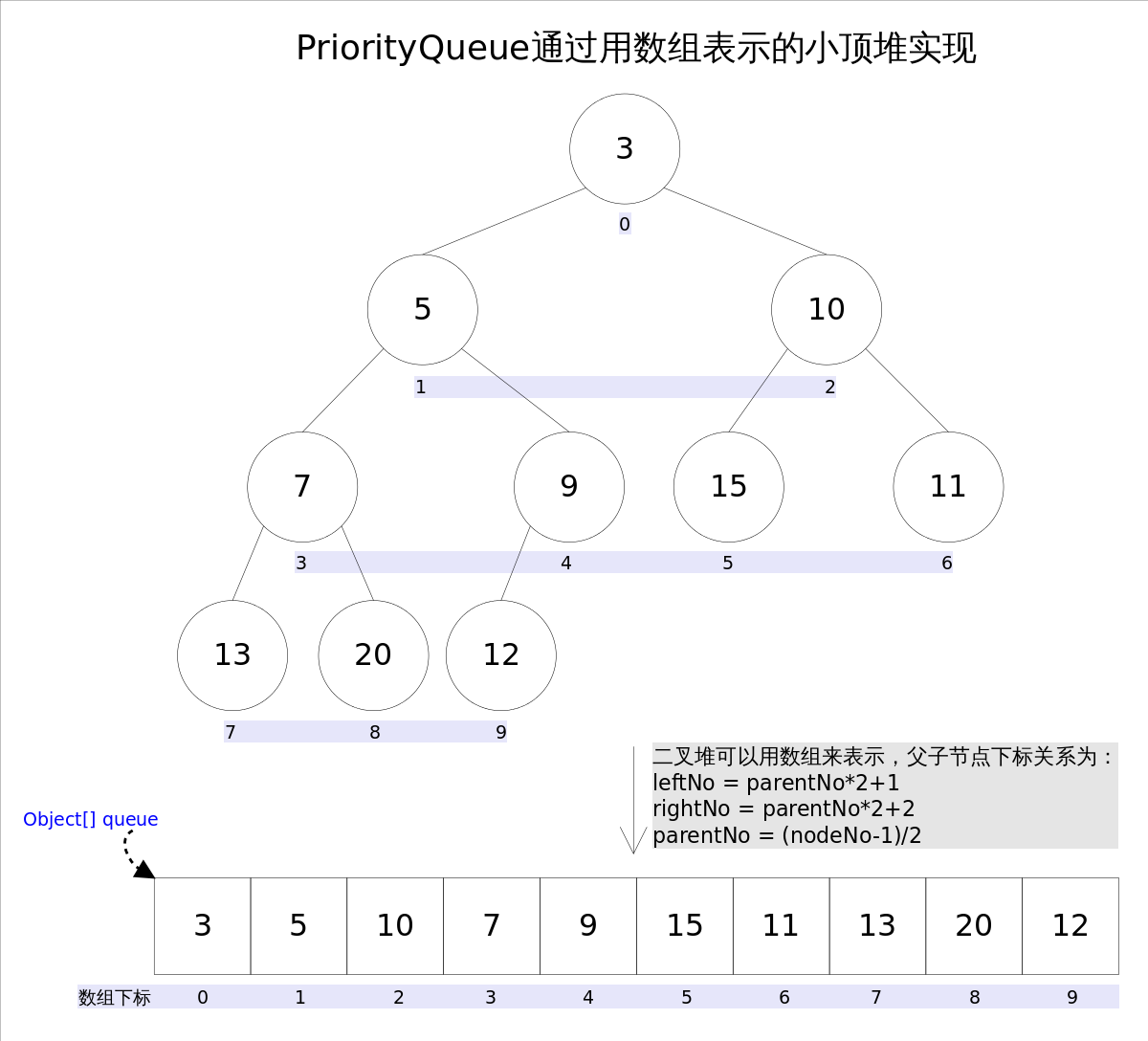1.总体介绍
PriorityQueue通过二叉小顶堆实现,可以用一棵完全二叉树表示。优先队列,能保证每次取出的元素都是队列中权值最小的。元素大小的评判可以采用自然排序也可以通过传入的comparator比较器进行排序。
Java中的PriorityQueue实现了Queue接口,不允许放入null元素,其通过堆实现,具体说是通过完全二叉树实现的小顶堆(任意一个非叶子节点的权值都不大于其左右节点的权值),也就是意味着可以通过数组来作为PriorityQueue的底层实现。

2.属性分析
| 默认初始容量11 private static final int DEFAULT_INITIAL_CAPACITY = 11; 非私有以简化嵌套类访问,定义数组,存放数据 transient Object[] queue; private int size = 0;数组里元素的个数 比较器,用于定义比较规则 private final Comparator<? super E> comparator; 被修改的次数 transient int modCount = 0; |
3.构造函数
|
无参构造器,使用默认容量DEFAULT_INITIAL_CAPACITY,调用PriorityQueue(int initialCapacity,Comparator<? super E> comparator) public PriorityQueue() { this(DEFAULT_INITIAL_CAPACITY, null); }
初始容量构造器,使用riorityQueue(int initialCapacity,Comparator<? super E> comparator)完成 public PriorityQueue(int initialCapacity) { this(initialCapacity, null); }
默认容量,传入比较器定义比较规则,调用riorityQueue(int initialCapacity, Comparator<? super E> comparator) public PriorityQueue(Comparator<? super E> comparator) { this(DEFAULT_INITIAL_CAPACITY, comparator); }
核心构造器,为queue和comparator初始化 public PriorityQueue(int initialCapacity, Comparator<? super E> comparator) { if (initialCapacity < 1) throw new IllegalArgumentException(); this.queue = new Object[initialCapacity]; this.comparator = comparator; }
如果是sortedset类型,使用sortedset的比较器调用initElementsFromCollection方法,如果是优先队列类型,就使用优先队列的比较器,调用initFromPriorityQueue,如果是其他类型,采用自然排序,调用initFromCollection public PriorityQueue(Collection<? extends E> c) { if (c instanceof SortedSet<?>) { SortedSet<? extends E> ss = (SortedSet<? extends E>) c; this.comparator = (Comparator<? super E>) ss.comparator(); initElementsFromCollection(ss); } else if (c instanceof PriorityQueue<?>) { PriorityQueue<? extends E> pq = (PriorityQueue<? extends E>) c; this.comparator = (Comparator<? super E>) pq.comparator(); initFromPriorityQueue(pq); } else { this.comparator = null; initFromCollection(c); } }
----------------------------------------------------
private void initElementsFromCollection(Collection<? extends E> c) { Object[] a = c.toArray(); 将c变为object数组,如果不是object数组,就重新copy成object数组 if (a.getClass() != Object[].class) a = Arrays.copyOf(a, a.length, Object[].class); int len = a.length; 此处len == 1 || this.comparator != null暂不明白,主要目的是不让数组中有null if (len == 1 || this.comparator != null) for (int i = 0; i < len; i++) if (a[i] == null) throw new NullPointerException(); 此时分为有序和无序,如果是有序,sortedset,直接数组输出就是有序数组,即符合小根堆;如果无序,也将其转为数组,并赋值为queue,然后使用heapify进行调整 this.queue = a; this.size = a.length; } ---------------------------------------------------------- 如果是priorityQueue类型,直接转为数组赋值,不需重新调整,这里不明白else什么情况会出现 private void initFromPriorityQueue(PriorityQueue<? extends E> c) { if (c.getClass() == PriorityQueue.class) { this.queue = c.toArray(); this.size = c.size(); } else { initFromCollection(c); } } 先调用initElementsFromCollection给queue赋值,然后进行调整 private void initFromCollection(Collection<? extends E> c) { initElementsFromCollection(c); heapify();堆处理,后面详讲 } --------------------------------------------------
public PriorityQueue(PriorityQueue<? extends E> c) { this.comparator = (Comparator<? super E>) c.comparator(); initFromPriorityQueue(c); } public PriorityQueue(SortedSet<? extends E> c) { this.comparator = (Comparator<? super E>) c.comparator(); initElementsFromCollection(c); } |
4.扩容机制
| private static final int MAX_ARRAY_SIZE = Integer.MAX_VALUE - 8; 扩容机制;在size》=queue.length时,会调用grow进行扩容 private void grow(int minCapacity) { int oldCapacity = queue.length; // Double size if small; else grow by 50% int newCapacity = oldCapacity + ((oldCapacity < 64) ? (oldCapacity + 2) : (oldCapacity >> 1)); // overflow-conscious code if (newCapacity - MAX_ARRAY_SIZE > 0) newCapacity = hugeCapacity(minCapacity); queue = Arrays.copyOf(queue, newCapacity); } 获取oldCapacity=queue.length;如果old小于64,使用new = old + old + 2; 如果old大于64,使用new=old + old / 2;如果newCapacity比MAX_ARRAY_SIZE大,就调用hugeCapacity和ArrayList一样;最后复制原数组的元素,并返回一个新长度的数组 --------------------------------------------------------
private static int hugeCapacity(int minCapacity) { if (minCapacity < 0) // overflow throw new OutOfMemoryError(); return (minCapacity > MAX_ARRAY_SIZE) ? Integer.MAX_VALUE : MAX_ARRAY_SIZE; } |
5.添加元素
| 实际调用offer public boolean add(E e) { return offer(e); } 插入元素 public boolean offer(E e) { if (e == null) throw new NullPointerException(); modCount++; int i = size; if (i >= queue.length) grow(i + 1); size = i + 1; if (i == 0) queue[0] = e; else siftUp(i, e); return true; } 如果为空抛出异常,如果size>=queue.length,扩容,否则size+1;如果i=0; 表明queue为空,直接将第一个元素进行赋值,如果i>0;当前元素和上层元素进行调整,插入元素时从下往上,删除元素是,将最后一个元素放到堆顶,然后从上往下调整 ---------------------------------------------------- private void siftUp(int k, E x) { if (comparator != null) siftUpUsingComparator(k, x); else siftUpComparable(k, x); } 如果比较器为空,使用x自带的排序方法或者实现comparable的compareTo方法,如果比较器不为空,使用比较器排序 -------------------------------------------------------------- 使用比较器的向上调整 private void siftUpUsingComparator(int k, E x) { while (k > 0) { int parent = (k - 1) >>> 1; Object e = queue[parent]; if (comparator.compare(x, (E) e) >= 0) break; queue[k] = e; k = parent; } queue[k] = x; } K表示插入后的下标即size-1,k>0时循环:得到新插入节点的父亲的下标,parent=(k-1)/2,如果x比父亲大或相等,结束,queue[k] = x,插入后就是小根堆,如果x比父亲小,由于父亲肯定比孩子小,那么将父亲的值给插入的位置queue[k] = e;,继续向上找比x小的数,知道找到,或者到堆顶,结束 ------------------------------------------------------------- 原理同上,只是比较的方法不同 private void siftUpComparable(int k, E x) { Comparable<? super E> key = (Comparable<? super E>) x; while (k > 0) { int parent = (k - 1) >>> 1; Object e = queue[parent]; if (key.compareTo((E) e) >= 0) break; queue[k] = e; k = parent; } queue[k] = key; } |
6.查找,取出元素
| 返回堆顶元素,就是数组第一个 public E peek() { return (size == 0) ? null : (E) queue[0]; } 返回并移除堆顶元素,移除之后得调整 public E poll() { if (size == 0) return null; int s = --size; modCount++; E result = (E) queue[0]; E x = (E) queue[s]; queue[s] = null; if (s != 0) siftDown(0, x); return result; } 如果size 为0,返回null,否则,size-1,得到堆顶元素result,然后得到最后一个元素赋值为x,把最后一个元素设为null;然后从堆顶开始,与x进行比较调整 ------------------------------------------------------------------ 如果comparator不为空,调用siftDownUsingComparator调整,如果不为空,使用自然排序或者comparable实现的compareTo方法。 private void siftDown(int k, E x) { if (comparator != null) siftDownUsingComparator(k, x); else siftDownComparable(k, x); } ---------------------------------------------------------------- private void siftDownComparable(int k, E x) { Comparable<? super E> key = (Comparable<? super E>)x; int half = size >>> 1; // loop while a non-leaf while (k < half) { int child = (k << 1) + 1; // assume left child is least Object c = queue[child]; int right = child + 1; if (right < size && ((Comparable<? super E>) c).compareTo((E) queue[right]) > 0) c = queue[child = right]; if (key.compareTo((E) c) <= 0) break; queue[k] = c; k = child; } queue[k] = key; } 使用x的comparable接口方式,得到最后一个元素的父亲,就是最后一层非叶子节点层,即倒数第二层;即half=size/2;如果k<half,循环进入;得到k的左右孩子child和right,如果右孩子的下标比size大或者相等,则没有右孩子;因此if条件,right<size并且左孩子>右孩子;child默认为小的那个下标,如果右孩子小,就将right赋值为child,记录小的对象为c;将c与key进行比较,如果key小于等于c,就结束循环,调整完成,否则将c赋值为queue[k],k = child,继续向下调整。 ------------------------------------------------------------------- 除了比较方法不一样,其他都一样 private void siftDownUsingComparator(int k, E x) { int half = size >>> 1; while (k < half) { int child = (k << 1) + 1; Object c = queue[child]; int right = child + 1; if (right < size && comparator.compare((E) c, (E) queue[right]) > 0) c = queue[child = right]; if (comparator.compare(x, (E) c) <= 0) break; queue[k] = c; k = child; } queue[k] = x; } |
7.删除元素
| 删除指定元素,先得到元素的下标,然后调用removeAt进行删除 public boolean remove(Object o) { int i = indexOf(o); if (i == -1) return false; else { removeAt(i); return true; } } ---------------------------------------------------- private int indexOf(Object o) { if (o != null) { for (int i = 0; i < size; i++) if (o.equals(queue[i])) return i; } return -1; } 遍历数组,直到equal方法为true ---------------------------------------------------------------- private E removeAt(int i) { // assert i >= 0 && i < size; modCount++; int s = --size; if (s == i) // removed last element queue[i] = null; else { E moved = (E) queue[s]; queue[s] = null; siftDown(i, moved); if (queue[i] == moved) { siftUp(i, moved); if (queue[i] != moved) return moved; } } return null; } 如果下标与-1后的size相同,说明删除最后一个元素,直接将其值置为null,否则,得到最后一个元素,将最后一个元素置为null,从第i个下标开始调整。 使用==判断相等 boolean removeEq(Object o) { for (int i = 0; i < size; i++) { if (o == queue[i]) { removeAt(i); return true; } } return false; } |
